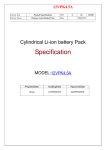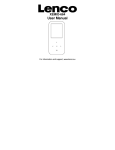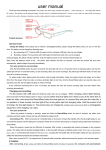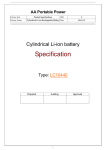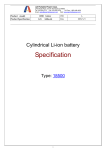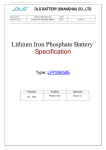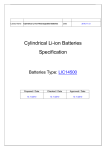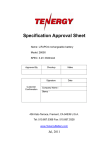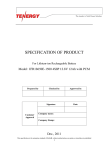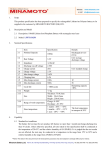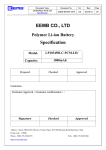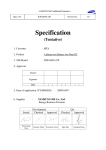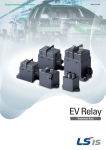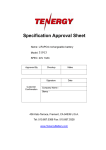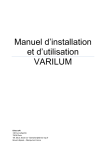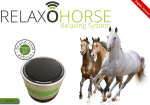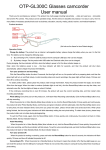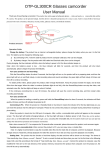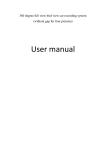Download MINAMOTO BATTERY LTD.
Transcript
The Source of Electric Power ® MINAMOTO BATTERY LTD. Flat A-6, 8/F., Mai Hing Industrial Building, 16-18 Hing Yip Street, Kwun Tong, Kowloon, Hong Kong. Tel: (852) 2793 4790 Fax: (852) 2793 4932 E-mail: [email protected] Technical Specification Page 1 of 1 Model: LI-18650 1. Primary technical Parameters :Rechargeable Type Lithium-ion Cylindrical Cell :Φ=18.2±0.2mm Dimension :H=64.5±0.5mm :2200 C5mAh :2200 C5mA :3.7V Nominal Voltage :Nominal 2200mAh Minimum 2150mAh Capacity when discharged at 0.2C5mA to 2.75V : 440mA ~ 1500mA charge Recommended Charging termination control parameters Conditions taper current 20mA at 4.2V Maximum :3000mA continuous discharge current :300cycles(≥80% C5mAh) Service Life :Approx.47g Weight Internal :≤80mΩ max. at 1000Hz Resistance :4.200±0.05V Charging Voltage Ambient :Charging :-20~+45℃ Temperature Discharging :-20~+60℃ Range Storage :-5~+35℃ Charging Characteristic Discharging Characteristic 9 18.2 64.5 Temperature Characteristic Note: 1、C5:the rated capacity, unit: Ah or mAh. Subject to change without prior notice unit:mm The Source of Electric Power ® MINAMOTO BATTERY LTD. Flat A-6, 8/F., Mai Hing Industrial Building, 16-18 Hing Yip Street, Kwun Tong, Kowloon, Hong Kong. Tel: (852) 2793 4790 Fax: (852) 2793 4932 E-mail: [email protected] Technical Specification 2. Performance Test item (1)Outside Appearance (2)Standard test conditions (3) Standard Charge (4)Standard discharge (5)Fast charge (6)Open-circuit voltage(OCV) (7)Rated Capacity (8)high-rate discharged Capacity (9)Cycle Life (20℃) (10)Low Temperature discharge (11)Storage characteristics Page 2 of 2 Test conditions Visual check Requirements No abnormal stain, Deformation nor damage Measurements are carried out at 20 ± 5 ℃ and relative humidity of 65 ± 20% without other specified condition. Accuracy of voltmeters and ammeters used in test is equal to or better than the grade 0.5. Cells shall be charged continuously at the constant current of 0.5 C5mA to 4.2V, then charge at the constant voltage of 4.2V until the end current of 20mA Cells shall be discharged continuously at the constant current of 0.2 C5mA to 2.75V Cells shall be charged continuously at the constant current of 1500mA to 4.2V, then charge at the constant voltage of 4.2V until the end current of 20mA ≥3.75V Cells shall be charged in Item (3) and discharged in Item (4) within 30minutes after full charged. If the discharge duration does not reach the specified value, the test may be repeated up to three times in total. Cells shall be charged in Item (3) and discharged continuously at the constant current of 1500mA to 2.75V within 30minutes after full charged. If the discharge duration does not reach the specified value, the test may be repeated up to three times in total. Cells shall be charged continuously at the constant current of 0.5C5mA to 4.2V and discharged continuously at the constant current of 0.5C5mA to 2.75V.A cycles defined as one charge and discharge . Carry out cycles until discharge capacity <80% C5mAh Cells shall be stored under -20℃±2℃ for 16h~24h after charged in Item (3),then discharged at constant current of 0.2 C5mA to 2.75V Cell shall be charged in Item (3) ,and stored in a temperature-controlled environment at 20±5℃ for 28 days. After storage, cell shall be discharged in Item (4) to obtain the remaining capacity. Rated capacity: ≥100%C5mAh Discharge capacity: ≥95%C5mAh ≥300 cycles Discharge capacity: ≥60%C5mAh Remaining capacity 90%C5mAh ≥ The Source of Electric Power ® MINAMOTO BATTERY LTD. Flat A-6, 8/F., Mai Hing Industrial Building, 16-18 Hing Yip Street, Kwun Tong, Kowloon, Hong Kong. Tel: (852) 2793 4790 Fax: (852) 2793 4932 E-mail: [email protected] Technical Specification 3.Mechanical test Test Item (1)Vibration Test (2) Drop Test 4.Safety Evaluation Test Item (1)Hot Oven Test (2)Short Circuit Test (3)Overcharge (4)Dip test Page 3 of 3 Test Conditions Vibrate test sample for 90minutes per each of the three mutually perpendicular axis(x,y,z)after rated charge. Amplitude: 0.38mm(10-30Hz);0.19mm(30-55Hz) Frequency: 10-55Hz(1oct/min) Direction: X, Y After test , cells are discharge at constant current of 0.2ItmA,and cycles per 1(3)and 1(4)for 3 cycles to obtain recovered capacity Drop 100% charged test sample from 1 meter above onto concrete board with more than 5cm thickness two times each for every direction after rated charge.After test , cells are discharge at constant current of 0.2 C5mA and cycles per 1(3)and 1(4)for 3 cycles to obtain recovered capacity Test Conditions The charged batteries are to be heated in a gravity convection or circulating air oven. The temperature of the oven is to be raised at a rate of 5±2℃ per minute. The oven is to remain for 30 minutes at 130±2℃ before the test is discontinued. After fast charge at 20±2℃, Connect battery terminals with electric wire ( electric resistance: 50mΩ or less ). And stop the test when the temperature of battery is 10℃ lower than peak temperature. After discharged at 1 C5mA and to 2.75V, the batteries shall be charged at 3 C5mA current with a voltage limit of 4.6V.chargeing is continued for 8 hours The charged battery shall be dipped in water for 24h in an ambient temperature of 20℃±5℃. Requirements No rupture, fire, smoke, Nor critical damage ≧90% C5mAh No rupture, fire, smoke, Nor critical damage ≧90% C5mAh Requirements No fire, Nor explosion No fire, Nor explosion No fire, Nor explosion No fire, Nor explosion 5.Charge State of Battery before shipment To be determined.(Recommendation Approx. 3.75 – 3.85V 30% charge) 6.Duration of guarantee the product We can keep on the quality in six month. 7.Protection When Li-ion rechargeable battery is used over the permitted voltage or current, electrolyte may disassemble, and this case will affect safety performance of Li-ion rechargeable battery. So“PTC heat-fuse” and protection circuit module were used in order to prevent overcharge, overdischarge and overcurrent. The parameters of protection circuit module as follows: overcharge protection voltage 4.250±0.025V overdischarge protection voltage 2.30±0.08V overcurrent protection ≤5.0A The Source of Electric Power ® MINAMOTO BATTERY LTD. Flat A-6, 8/F., Mai Hing Industrial Building, 16-18 Hing Yip Street, Kwun Tong, Kowloon, Hong Kong. Tel: (852) 2793 4790 Fax: (852) 2793 4932 E-mail: [email protected] Technical Specification Page 4 of 4 8.Handling precautions on Lithium Ion Rechargeable Battery To assure product safety, describe the following precautions in the instruction manual of the equipment. ! Danger - When charging the battery, use dedicated chargers and follow the specified conditions. - Use the battery only in the specified equipment. - Do not connect battery directly to an electric outlet or cigarette lighter charger. - Do not heat or throw battery into a fire. - Do not use, leave battery close to fire or inside of a car where temperature may be above 60℃. Also do not charge / discharge in such conditions. - Do not immerse, throw, and wet battery in water/ seawater. - Do not put batteries in your pockets or a bag together with metal objects such as necklaces. Hairpins, coins, or screws. Do not store batteries with such objects. - Do not short circuit the (+) and (-) terminals with other metals. - Do not place battery in a device with the (+) and (-) in the wrong way around. - Do not pierce battery with a sharp object such as a needle. - Do not hit with a hammer, step on or throw or drop to cause strong shock. - Do not disassemble or modify the battery. - Do not solder a battery directly. - Do not use a battery with serious scar or deformation. ! Warning - Do not put battery into a microware oven, dryer, or high-pressure container. - Do not use battery with dry cells and other primary batteries, or batteries of a different package, type, or brand. - Stop charging the battery if charging is not completed within the specified time. - Stop using the battery if abnormal heat, odor, discoloration, deformation or abnormal condition is detected During use, charge, or storage. - Keep away from fire immediately when leakage or foul odor is detected. - If liquid leaks onto your skin or clothes, wash well with fresh water immediately. If liquid leaking from the battery gets into your eyes, do not rub your eyes. Wash them well with clean water and go to see a doctor immediately. ! Caution - Store batteries out of reach of children so that they are not accidentally swallowed. - If younger children use the battery, their guardians should explain the proper handling. - Before using the battery, be sure to read the user’s manual and cautions on handling thoroughly. - Thoroughly read the user’s manual for the charger before charging the battery. - For information on installing and removing from equipment, thoroughly read the user’s manual for the specific equipment. - Batteries have life cycles. If the time that the battery powers equipment becomes much shorter than usual, the battery life is at an end. Replace the battery with a new same one. - Remove a battery whose life cycle has expired from equipment immediately. - When the battery is thrown away, be sure it is non-conducting by applying vinyl tape to the (+) and (-) terminals. - When not using battery for an extended period, remove it from the equipment and store in a place with low humidity and low temperature. - While the battery pack is charged, used and stored, keep it away from objects or materials with static electric charges. - If the terminals of the battery become dirty, wipe with a dry clothe before using the battery. - The battery can be used within the following temperature ranges. Do not exceed these ranges. Charge temperature range : 0℃ to 45℃ Discharge temperature range : -20℃ to 60℃ (When using equipment)




